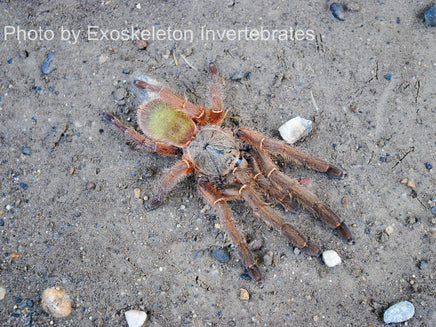
Ephebopus uatuman: The Emerald Skeleton Tarantula
Meet the stunning Ephebopus uatuman, commonly known as the Emerald Skeleton Tarantula. This captivating species is renowned for its vibrant coloration and striking skeletal leg pattern. Native to the lush rainforests of Brazil, the Emerald Skeleton is a truly unique addition to any collection, offering a blend of beauty and intrigue with its fascinating behaviors and impressive appearance.
Care Details:
- Temperature: Ideal range for most tarantulas is 75 to 85°F (24 to 29°C). Tarantulas in warmer environments eat more, grow faster, and molt quicker. This care flexibility makes tarantulas easy to maintain.
- Humidity: 70-80%. Water dishes are not necessary, but if used, they pose no harm. I personally do not use them.
Diet:
I personally give them a variety of crickets and cockroaches, including Dubia, Red-runner, Lobster, and Madagascar hissing roaches. For the baby tarantulas, baby crickets and baby roaches are ideal. If you have access to only one type of prey, that is also perfectly fine.
In-depth Facts:
- Latin name: Ephebopus uatuman
- Common name: Emerald Skeleton Tarantula
- Locale: Brazil
- Category: Terrestrial, moderate webber
- Size: Females up to 5 inches, males slightly smaller
- Urticating hairs: they do not use urticating hairs as a defense mechanism commonly, very rare.
- Growth rate: Moderate to fast
- Life span: Females can live up to 15 years, males typically 3 to 4 years
- Recommended levels: lovers of species that have super striking coloration, and that love to be a bit fossorial.
Stay Connected:
- Instagram: Follow my Instagram, I'm most active here.
- YouTube: For care and education videos, check out my YouTube channel.
- Facebook: Over here I have all my reviews.
- TikTok: Visit my TikTok for additional content.
Safety Disclaimer:
Experiencing a tarantula bite is an extremely rare occurrence, and it's important to note that there have been no recorded fatalities due to a tarantula bite. The venom potency varies across species, with Old World tarantulas generally having stronger venom than their New World counterparts. Within the Old World category, the Poecilotheria genus is known for having particularly potent venom.
It's crucial to approach tarantulas with respect and understanding. If you happen to get bitten, which is unlikely, the key is to stay calm. In most cases, the discomfort is superficial and subsides within a few minutes to a few hours. However, bites from species with more potent venom may result in symptoms lasting up to a week. Remember, larger tarantulas tend to have more venom than smaller ones.
Please be aware that I cannot assume responsibility for bites. Tarantula handling should be done at your own risk. In my 11 years of experience with these creatures, I have only been bitten once, by a species with highly potent venom. While the experience was painful, the symptoms had completely disappeared after a week.
Handle tarantulas responsibly, and always prioritize your safety and the well-being of the tarantula.